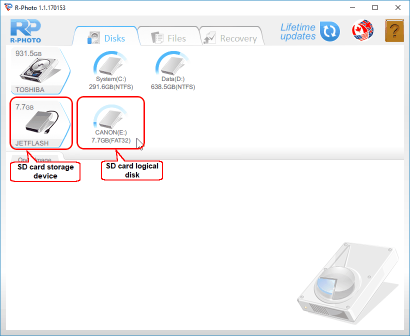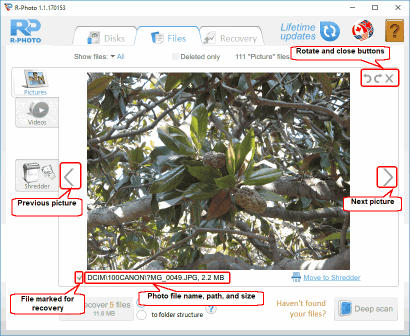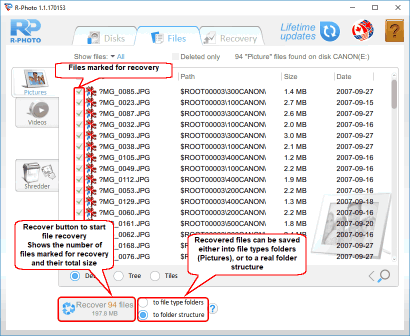


-
Free Recovery from SD and Memory cards
You may read about how to recover files on other cases:
So, what do you have to do to get deleted files back?
HD Video Recovery from SD cards
Recovery from an External Device with a Damaged File System
R-Undelete: File recovery from a non-functional computer
Most consumer and professional digital photo cameras store images on a memory card, such as a Secure Digital (SD) flash card or a CompactFlash card. Memory cards are often accidentally formatted (e.g. when loading them into another device) or individual photos may be inadvertently deleted by the camera or a computer. Furthermore, memory cards can become corrupted if they are ejected improperly, rendering them unreadable. These accidents happen frequently, even to advanced digital camera users. Luckily, recovering photos from digital camera memory cards - whether the photo was deleted or the card was formatted or damaged - is free and relatively easy with R-Photo.
Compared to recovering lost, damaged or deleted files from other media, such as a hard disk drive, undeleting files from a memory card isn't very different. In fact, the chances for successfully recovering files from digital camera memory cards is often higher due to three typical features: memory cards tend to be smaller in capacity (128 GB or less); files on the card are usually not fragmented; and memory cards tend to contain only photos and movies.
In this article, we'll walk you through two of the most common scenarios. First, we'll show you how to use R-Photo to recover photos that were accidentally deleted from a memory card. We'll also show you how to recover photos after a memory card has been formatted, or if the file system on the card has been damaged. In most cases, files can even be recovered even if the card is unreadable by a computer or digital camera.
Before You Begin
The first thing you should do after accidentally deleting photos or formatting a memory card is to stop using it immediately. Writing to a card, and even reading from a card, can overwrite your salvageable data, decreasing your chances for a successful recovery. Avoid using the card until all undelete efforts have been exhausted.
If you haven't already, download and install a copy of R-Photo. See the Download Instructions and Info web page for details.
Also, before we begin, it's worth knowing how digital photos are stored on memory cards. Your digital camera will typically create an automatically generated file/folder structure. This varies from camera-to-camera, but in general, it includes a number and the camera manufacturer. For example, here's a screenshot of a file/folder structure created by a Canon digital camera:

Click image to enlarge
If the camera were a Nikon, the folders may be named something like 100NIKON, 200NIKON, etc. Recognizing these patterns is one of the ways that R-Photo increases your chances of recovering deleted photos.
Once you have R-Photo installed on your machine, you can insert the card into a card reader connected to your computer. You can use an external card reader that connects via USB, or use a built-in card reader on your computer's tower (or on your laptop) or on your printer. Once inserted, your computer will recognize the card and will display it as a disk on the R-Photo panel.
Note: If the card's file system is damaged, it may not appear in the R-Photo panel as a logical disk. In this case file recovery may still be possible; skip down to the Recovering Photos from Damaged or Formatted Memory Cards section for details.
Recovering Deleted Photos
Digital photos can be deleted by your computer or by the camera itself. In either case, deleted photos can typically be recovered wholly intact. For this tutorial, we'll assume that nothing has been written to the card since the deletion occurred. While it may still be possible to recover photos if you have used the card after a deletion, your chances are much greater if you attempt an undelete procedure as soon as possible.
Launch R-Photo. In the Disks panel, locate your memory card's storage device and logical disk. You can usually recognize a memory card by its size (~1 GB to 256 GB, rather than 500 GB or more, like a hard drive)

Click image to enlarge
Move the mouse cursor over the SD card logical disk and click the Show files menu item that will appear under the disk icon.
R-Photo will start searching for files on the SD card. When the search is through, the program will show found files on the Files panel. Now it is necessary to search for the files you want to recover.
R-Photo shows found photos in the Pictures tab. This tab has the default option to display files: tiles. You may select their size:

Click image to enlarge
You can also find files by searching for them manually. To do so, click the Search button, specify the file name or file mask, click the Start button, and only the matched files will be shown on the current tab.
For more detailed instructions for sorting and creating manual search, refer to the R-Photo: File Search and File Sorting online help pages.
Although tiles allow you to see pictures quite clearly, you may examine the pictures more carefully by using the built-in viewer. Right-click the file to view it.

Click image to enlarge
Close the viewer to return to other files.
When your deleted files are found, mark them for recovery. It's easier to do that when the files are shown as a single file list with details (Details):

Click image to enlarge
When the required files are marked for recovery, sufficient storage space on another disk should be available to save them.
Never save the recovered files on the place where they were located, or you may completely lose them!
Select the way R-Photo saves the files: either into the file type folders or to the real folder structure.
When all the necessary preparations are made, click the Recover button to start file recovery. Wait for R-Photo to recover the files and see the results.

Click image to enlarge
When the recovery is over, the folder with recovered files will be automatically opened.

Click image to enlarge
Recovering Photos from Damaged or Formatted Memory Cards
There are two ways for photos to be lost from a memory card: deleting them one by one, or by formatting the memory card. Memory cards can be formatted by a computer or a camera, and is typically done to prepare it for use by the device. Before formatting a memory card, you'll be warned that this will completely erase the contents of the disk. But depending on the type of format you perform and how quickly you act, you can still recover photos that were previously written to that card even after it has been reformatted. Your chances of recovering deleted photos from a formatted memory card are greatest when a quick format has been performed. A quick format does not alter the contents of the card - it merely clears the file system to allow other devices or programs to overwrite your files. So long as no new data has been written to your card, you should be able to recover 100% of your old photos on a quick formatted memory card. Likewise, if a file system is corrupted or damaged, rendering the card unreadable (e.g. due to unsafely removing the disk while it was being accessed), you can recover the photos from it using R-Photo, even when Windows Explorer or The Finder can't recognize the card. Instead of relying on the card's file system to locate photos, R-Photo can perform a "Deep Scan" procedure to scan for known file types (raw file search). R-Photo will search for file signatures, which are like the fingerprint for photo and video types of files, and using these file signatures will be able to recover intact files.
Note: While the chances for successful recovery are very high with quick formats and formats performed by most cameras, full formats, secure formats and other advanced disk wiping processes may render the files irrecoverable. Again, you can estimate your chances for recovery using the R-Photo preview feature.
Launch R-Photo. In the Disks panel, locate your memory card's storage device and logical disk. You can usually recognize a memory card by its size (~1 GB to 256 GB, rather than 500 GB or more, like a hard drive)

Click image to enlarge
Move the mouse cursor over the SD card logical disk and click the Show files menu item that will appear under the disk icon.
But in this case, R-Photo will not find any files because no files exist after device format. You can try running a deep scan to find the lost files. During this procedure, R-Photo deeply analyzes all data on the disk including parsing information about files and searching for files using their file signatures. You may read more about the Deep Scan procedure and file signatures on the R-Photo: Deep Scan online help page.

Click image to enlarge
Click the Deep scan button. R-Photo will start scanning. You can see the scan progress as R-Photo analyzes your SD card.

Click image to enlarge
Depending on your hardware, scan time may vary, even within the same scan process, and may be quite lengthy for large SD cards. Deep scan may be paused then resumed it by clicking the Resume scan button.
You may search for files and view them as it's described in the Recovering Deleted Photos section.
When your deleted files are found, mark them for recovery:

Click image to enlarge
When the required files are marked for recovery, sufficient storage space on another disk should be available to save them.
Never save the recovered files on the place where they were located, or you may completely loose them!
Select the way R-Photo saves the files: either into the file type folders or to the real folder structure.
When all the necessary preparations are made, click the Recover button to start file recovery. Wait for R-Photo to recover the files and see the results.

Click image to enlarge
When the recovery is over, the folder with recovered files will be automatically opened.

Click image to enlarge
Conclusion
It's all too easy to delete photos from a memory card, whether it's due to accidental deletion of one or two files or an unintentional reformat. Fortunately, it's relatively easy to recover photos from a memory card using R-Photo. R-Photo offers two powerful file recovery methods that are perfectly tailored for these scenarios. The "Search for files" lets you undelete photos before they are overwritten, while the Deep scan allows you to access photos even if the file system has been formatted or damaged. So, before you panic, before you pay a technician hundreds of dollars, and above all, before you begin writing new data to the card, run these scans on the card using R-Photo to see if your lost photos can be recovered. R-Photo recovers files from SD cards without registration, that is, for free.
- R-Studio Technician: activation using a USB stick
- Data Recovery Guide
- Why R-Studio?
- R-Studio for Forensic and Data Recovery Business
- R-STUDIO Review on TopTenReviews
- File Recovery Specifics for SSD devices
- How to recover data from NVMe devices
- Predicting Success of Common Data Recovery Cases
- Recovery of Overwritten Data
- Emergency File Recovery Using R-Studio Emergency
- RAID Recovery Presentation
- R-Studio: Data recovery from a non-functional computer
- File Recovery from a Computer that Won't Boot
- Clone Disks Before File Recovery
- HD Video Recovery from SD cards
- File Recovery from an Unbootable Mac Computer
- The best way to recover files from a Mac system disk
- Data Recovery from an Encrypted Linux Disk after a System Crash
- Data Recovery from Apple Disk Images (.DMG files)
- File Recovery after Re-installing Windows
- R-Studio: Data Recovery over Network
- How To Use R-Studio Corporate Package
- Data Recovery from a Re-Formatted NTFS Disk
- Data Recovery from an ReFS disk
- Data Recovery from a Re-Formatted exFAT/FAT Disk
- Data Recovery from an Erased HFS Disk
- Data Recovery from an Erased APFS Disk
- Data Recovery from a Re-Formatted Ext2/3/4FS Disk
- Data Recovery from an XFS Disk
- Data Recovery from a Simple NAS
- How to connect virtual RAID and LVM/LDM volumes to the operating system
- Specifics of File Recovery After a Quick Format
- Data Recovery After Partition Manager Crash
- File Recovery vs. File Repair
- Data Recovery from Virtual Machines
- How to Recover Files from a Remote Computer Using R-Studio Standalone License and Its Network Capabilities in Demo Mode
- How to Connect Disks to a Computer
- Emergency Data Recovery over Network
- Data Recovery over the Internet
- Creating a Custom Known File Type for R-Studio
- Finding RAID parameters
- Recovering Partitions on a Damaged Disk
- NAT and Firewall Traversal for Remote Data Recovery
- Data Recovery from an External Disk with a Damaged File System
- File Recovery Basics
- Default Parameters of Software Stripe Sets (RAID 0) in Mac OS X
- Data Recovery from Virtual Hard Disk (VHD/VHDX) Files
- Data Recovery from Various File Container Formats and Encrypted Disks
- Automatic RAID Parameter Detection
- IntelligentScan Data Recovery Technology
- Multi-pass imaging in R-Studio
- Runtime Imaging in R-Studio
- Linear Imaging vs Runtime Imaging vs Multi-Pass Imaging
- USB Stabilizer Tech for unstable USB devices
- Joint work of R-Studio and PC-3000 UDMA hardware
- Joint work of R-Studio and HDDSuperClone
- R-Studio T80+ - A Professional Data Recovery and Forensic Solution for Small Business and Individuals Just for 1 USD/day
- Backup Articles
- R-Drive Image Standalone and Corporate license transferring
- Fixing Windows update error 0x80070643 with R-Drive Image
- Backup with Confidence
- R-Drive Image as a free powerful partition manager
- Computer Recovery and System Restore
- Disk Cloning and Mass System Deployment
- Accessing Individual Files or Folders on a Backed Up Disk Image
- R-Drive Image startup / bootable version
- File Backup for Personal Computers and Laptops of Home and Self-Employed Users
- Creating a Data Consistent, Space Efficient Data Backup Plan for a Small Business Server
- How to Move the Already Installed Windows from an Old HDD to a New SSD Device and Create a Hybrid Data Storage System
- How to Move an Installed Windows to a Larger Disk
- How to Move a BitLocker-Encrypted System Disk to a New Storage Device
- How to backup and restore disks on Linux and Mac computers using R-Drive Image
- Undelete Articles
- Get Deleted Files Back
- Free Recovery from SD and Memory cards
- R-Undelete: Video Recovery
- Recovery from an External Device with a Damaged File System
- File recovery from a non-functional computer
- Free File Recovery from an Android Phone Memory Card
- Free Photo and Video File Recovery Tutorial
- Easy file recovery in three steps
Rating: 4.9 / 5
This is the easiest and the quickest data recovery software I have come across. I had to recover photos and videos out of the corrupted SD card, I tried other paid software which takes 8 hours of the deep scan to come up with less than 50% of data to recover.
R-Photo did that in a few minutes and recovered more than 35 GB of photos & videos in less than an hour, without missing a single file.
Highly Recommended.




